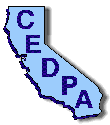
 |
California Educational Data Processing Association |
The DataBus - Vol. 37, No. 2
|
On October 23, 1996 the State Allocation Board (SAB) adopted a procedure to distribute $35,000,000 for technology grants under the Education Technology Grant Program of 1996. Bills AB 1302 and AB 1519 were signed into law and authorize the Public Utilities Commission (PUC) to allocate funds for the purpose of telecommunications development in public schools. This grant may be used for purchase or lease of computer hardware, software and staff development training.
"We have tried to make this grant process as simple as the legislation will allow. This is a wonderful opportunity for schools to obtain technology grant dollars in a non-competitive fashion," said Kathie Bovard, Associate Management Auditor of the Office of Public School Construction.
These grants will be a boon to small school districts. Each district must designate a single site to benefit from the grant. Unified school districts must choose between seeking funds for a K-8 school or a 9-12 school. After completing a qualifying application each school will receive a $21,500 matching grant. These grants are non-competitive. Each district that submits a qualifying application will receive funding. Each grant will be accompanied by a $4,000 staff development grant to be used at that site.
Please note that the district match may include in-kind services, such as teacher labor, the fair market value of donated equipment raised from local sources, or other services outlined in the plan. Financial hardship waivers for the matching requirement can be approved by the State Department of Education. Matching funds are not required for the $4,000 staff development grants.
The remaining balance of funds, $6,717,500, will be distributed among qualified applicants based on student enrollment. Unified districts may only use their enrollment for the grade range they choose to apply. For example, a unified school district with a K-12 enrollment of 10,000 students has a K-8 enrollment of 9,000 and has applied for a K-8 school site grant may only use their K-8 enrollment of 9,000 students for their additional funding calculation.
Application packets were mailed the school district superintendents on November 8, 1996. A web site for this program may be found at http://www.dgs.ca.gov/opsc. This site contains the application forms and information need to qualify for the funds.
| Percent of Funds |
Allocation | |
| K - 8 schools | 50% | $ 17,500,000 |
| 9 - 12 | 34% | $ 11,900,000 |
| Administrative Costs | 1% | $ 350,000 |
| Staff Development Grant funds to CDE |
15% | $ 5,250,000 |
| Total | 100% | $ 35,000,000 |
Applications are due in the Office of Public School Construction (OPSC) by 5:00 p.m., Friday, February 28, 1997. If you have any questions regarding this program, please contact Kathie Bovard at (916) 322-0317 (e-mail address: [email protected]) or Michael Willis at (916) 322-9448 (e-mail address: [email protected]).
Much of this article was contributed by online resources of the FCC, CPUC and the California Department of Education. Sources are quoted in the text of the article.
The grant guidelines are as follows: a minimum of 90 percent of the grant amount will be used for wiring classrooms, school libraries, and conference rooms, or the purchase of hardware and software necessary for telecommunications and information services for instructional purposes. Further, AB 1519 requires each applicant school districts and county offices of education to match at least 50 percent of the cost of the technology implementation plan submitted to the State Allocation Board. Matching may consist of in-kind services, such as teacher labor, the fair market value of donated equipment raised from local sources, or other services outlined in the plan. Financial hardship waivers for the matching requirement can be approved by the State Department of Education.
This article originally appeared in the Alameda County Office of Education Technology Newsletter and is reprinted by permission.